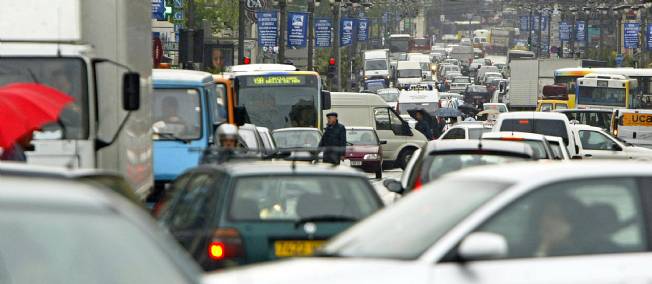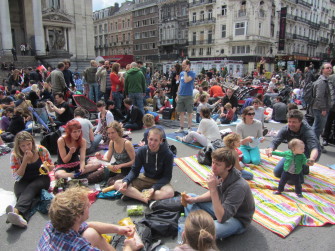
The missing link between wannabe “European Green Capital 2015” and being Europe’s most congested city – Civic movement reclaims the streets in Brussels.
No other city is more congested than Brussels, in no other European country do people waste more hours in congestion than in Belgium. The OECD recommends congestion charges. Meanwhile “PicNic the Streets” takes a second breath in 2013.
To many citizens of Brussels it may sound like a bad joke: Brussels is on the final short-list to be awarded the title “European Green Capital 2015”. The Belgian Capital already tried it in the past but failed due to bad scores on air quality and mobility. According to INRIX, a Dutch provider of traffic services, Brussels was in 2012 the most congested city in Europe, ahead of London and Antwerp. In Belgium, car drivers spent more hours in congestion than in any other European country.
What’s going wrong in Brussels, and by extension in Belgium?
First of all, it’s not all bad in Brussels, good things also do happen here thanks to active cycle advocacy of ECF members Fietsersbond and Gracq. However, these things happen mainly on the so-called ‘pull’-side: The Brussels Capital Region invests about 11 million Euro annually mainly in cycling infrastructure, or about 10 Euro per inhabitant – a figure that puts most other European cities into shadow, although the Regional Cycle Route network is still far from being completed. Brussels also has VILLO, a well-functioning bike-sharing system, with 5,000 bikes in use by this summer. And then there are a bunch of projects like BikeExperience by ProVelo, Cyclovia, bike-to-work… All these measures meant to encourage cycling seem to have a positive effect: cycling is in the lift, up from 1 % in the modal split about 10 years ago to 4 % last year. The objective of the Brussels mobility plan is to increase cycling to 20 % modal share by 2018; At the same time, car traffic shall reduce by 20 %, compared to 2001 levels.[i]
For that to achieve, Brussels would need to work very hard on the ‘push’-measures side. ‘Push’ measures are those imposed aimed at restricting car use by reducing the number of car parking and making car parking more expensive, by charging cars for entering parts of the city or by preventing them to cross city centres… The Brussels Capital Region so far fails badly on all these measures – not necessarily on paper, but in implementation.
The symbol of this failure is the inner-city North-South axis: open to car traffic, the Boulevard Anspach cuts the city centre in two halves. The square in front of the Brussels Stock Exchange (Place de la Bourse) is a noisy passage road. First announcements by the Mayor of Brussels City, Freddy Thielemans, to refurbish the Boulevard Anspach and restrict car use were made back in … 2001. Although he is still in office to date, nothing has happened.
PicNic the streets: citizen claiming for a change
This inactivity and lack of political leadership which seems to be a Belgian disease provoked last year the “PicNic the Streets” movement – with more than 2,000 people turning the Place de la Bourse into an area for children playing and grown-ups chatting. A turning point in the City’s approach to city planning and mobility?
A Belgian problem
To be fair to Brussels, not all the challenges can be solved by the Region itself but need to be addressed at national level. Brussels is flooded by nearly 250,000 commuter cars every day – 2/3 of all commuters arrive by car. The OECD complains in its Economic Survey on Belgium that policy is given the wrong incentives: “Tax treatment of company cars remains generous and company cars are much more widespread than in other countries”. The organisation also recommends the introduction of stronger price signals to secure a better use of infrastructures, including congestion charges in Brussels and Antwerp. The OECD says that there is much opposition to this kind of measure beforehand, but once people see the benefits, e.g. less congestion, a majority approve it.
Meanwhile Brussels Mayor Thielemans has announced that the central boulevard will be redesigned in 2015: if implemented, cars could not cross the Brussels city centre anymore but would need to take the inner-city ring road. Civic movement ‘PicNic the Streets’ has welcomed the announcements, however remains suspicious given the experiences of the past. It therefore has called for another ‘PicNic the Streets’ on June 9 to keep the pressure on – exactly one year after the 1st picnic.
Brussels “European Green Capital 2015”? It first should implement aforementioned push measures in order to really deserve it. At this moment, such a title would be pre-mature.
Link: Watch a 19 minute documentary about the live of bicycle messengers in Brussels: http://www.brusselsexpressfilm.be/documentary
 About the Author
About the Author
Fabian Küster is a Senior Policy Officer at the European Cyclists’ Federation. He has previously worked in Brussels for a German Member of European Parliament and the German Embassy. He has wealth of experience in and around the EU institutions, and is an expert in the EU policy field of bicycles
- Log in to post comments
Contact the author
Recent news!
Upcoming events
Contact Us
Avenue des Arts, 7-8
Postal address: Rue de la Charité, 22
1210 Brussels, Belgium











